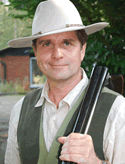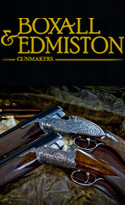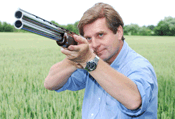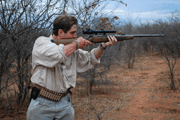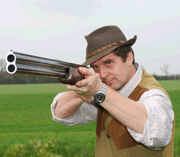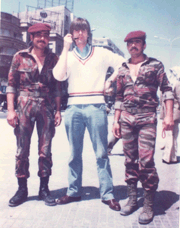The Practical Hunting rifle
Rifles are just as subject to fashion as lady’s handbags. If you look over the last hundred and fifty years or so, you will note 12 bore muskets giving way to ½” calibre weapons, then the rise of the 8mms, .30 cals, 7mms and 6.5s. War maybe hell, but it is also the spur to much technological development. Teddy Rosevelts boys armed with 30-40 Krags carbines got cut to bits by superior 7x57 Mauser model 1893s as they climbed San Juan Hill. Much the same happened to the Brits in the Boer war, though we were somewhat better armed.
7 and 8mm military arms have now, generally, been displaced by even smaller calibre weapons. The experience of sniping in both World Wars, moreover, profoundly changed the modern hunting rifle, as indeed, have the Iraq wars and Afghanistan more recently. Good telescopic sights were developed in the Great War. Both first and second wars led to a glut of surplus bolt-action weapons. After WWII especially - when people were generally better off than in previous generations - many returning GIs were firearms trained and attracted to hunting.
Tens of thousands of Mausers , Springfields, and Enfields were sporterised in this era to meet the demand. The day of the hunter sniper had arrived. As Weaver sighted .270s and similar came in, the popularity of the 30-30 lever gun receded in the States. Roy Weatherby developed his uber cartridges and somewhat garishly styled guns. Remington took note and introduced their glossy 700s - at far less cost - displacing more expensive to manufacture (but still desirable) Winchester pre-64 type rifles.
In the UK firms like Parker Hale sporterised vast numbers of both generic Mausers, and Enfields to appeal not just to the home stalking and target shooting market but also to create a product for export to the Commonwealth and USA. To this day, I can remember drooling over Parker Hale Safari models in their annual catalogue. BSA also made some excellent rifles in this era – the Monarchs and Viscounts. The calibres of choice were .270 and 30-06 (though many Enfields remained as 303s). The adoption of the 7.62mm NATO/.308 Winchester SLR, led to a demand for .308 sporting guns in Britain. The necked down .243 became a big hit on both sides of the Atlantic as well (and may still be the most popular rifle cartridge in Britain).
We have since seen the fashion for super .22 centre-fires (which grew out of the experience of US benchrest and varmint shooters), not to mention the 5.56/.223. What’s today’s big thing in the field? Well, you can’t ignore the craze for short magnums, but, as big a trend is the 6mm and 6.5, both of which have been rediscovered. And, as well as these, calibres there has been a trend towards heavy, synthetic or composite stocked, super accurate rifles - rifles that look much like the sort of kit that our special forces use in some of the less travelled parts of this world.
Now, there is no denying the sheer accuracy potential of these big guns - and I have a hankering for one on that count if nothing else (and I shall probably get Geoff Colby of Border Barrels to make it for me) but there remains a strong case, especially for the deer stalker, for a lighter style of rifle. Practical stalking at ethical ranges does not require a ¼” group capability. It requires a gun which is convenient to carry and which can be deployed quickly. For most practical purposes, a well zeroed gun that can manage 1 ½-2” at 100 yards is perfectly adequate (though we would all like to achieve the magic minute when possible).
I also like to use a sporting rifle that looks like a tool intended for sport rather than of war. Now, this is a very personal subject. I will, and have defended all shooting men and women’s rights to shoot what they want provided they are sane and sensible, but, in essence, I am a traditionalist. I like to take to the field with my little .308 Mannlicher stutzen. Wooden stocked, and light it may be with the funny twisty barrel and rotary mag, but it can still manage an 1” with the right loads and is extremely handy.
My friend Paul Roberts, one of the most experienced hunters on the planet, told me the other day: “I think many people get too obsessive about accuracy with their hunting guns. It’s important, but practical hunting accuracy and Bisley winning accuracy are different things. It does not make sense to sacrifice the practical utility of a rifle for an accuracy potential that will never be needed. I think that there is a trend towards guns that are too heavy and too long today. The widespread adoption of sound moderators - and of course they have their uses - can make some guns even more unwieldly. For me an ideal all-up weight for a stalking rifle would be 8lbs, certainly no more than 9 ½ including a scope. I have shorter barrels on most of my guns. They are much better for moving in woods or for climbing in and out of high seats and vehicles, and there is no significant loss of hunting accuracy.”
The idea of the light gun is to promote hunting in the traditional manner. I am not one for taking long shots on big game as previously noted in these pages. I like to get in within 150 yards, and, ideally, within 100. A lighter rifle is the tool for that job. Maybe that brings me full circle - back to the lever gun. I have .308 Sako that has given me sterling service for 30 years - though displaced in my affections in recent years by the Mannlicher and a .300 Win mag Tikka. Now, I am considering a Marlin in 45-70 for boar (though a .444 or .450 Marlin might be even better), or, re-barrelling the lever Tikka in .338 Federal (a necked up .308). That would be a really practical rifle for the woods that might be used for deer or boar. And, being .338 rather than .308 it would be legal for use in France as well (where military calibres are prohibited for game shooting).


